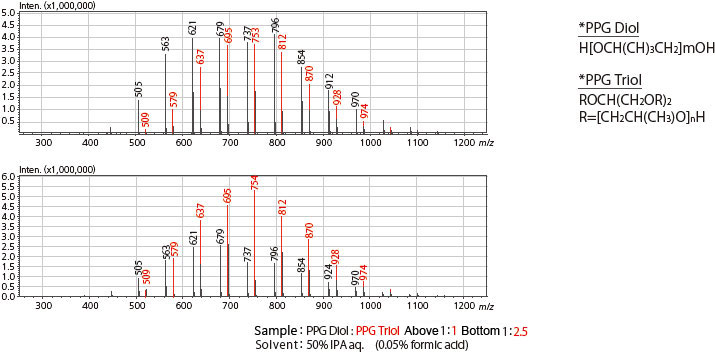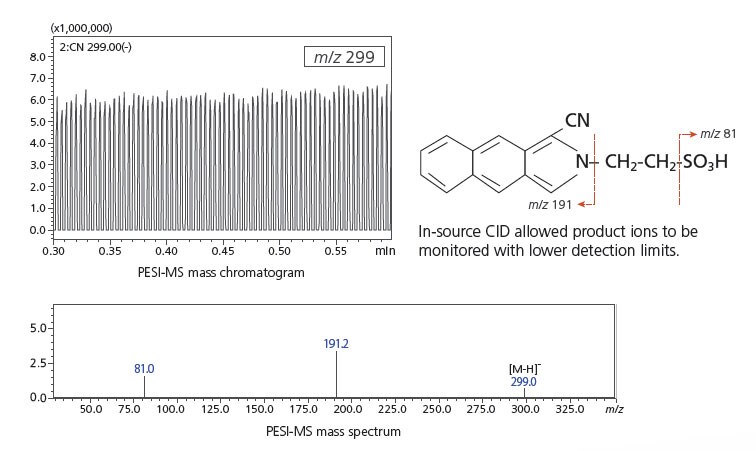DPiMS-2020 - Características
Probe Electrospray Ionization Mass Spectrometer
Perform MS analysis directly on the sample.
Analysis of Components in Surfactant Mixtures

An example of the screening of complex mixtures of cosmetics and personal care products in full-scan mode is shown below. Changes in spectral results indicate corresponding changes in composition. Samples can often be deposited directly onto the sample plate.

Detection of Cyanide in Serum

Analytical methods that can be performed immediately with only simple pretreatment are especially desirable in fields such as forensics. The following is an application for rapid screening of biomaterial samples suspected to contain cyanide compounds. Derivatizing agents (taurine and naphthalenedialdehyde) were added to a serum sample containing a trace quantity of cyanide, and the mixture was measured using a DPiMS-2020 system. In-source CID was used to enhance detection limits. Since only 10 μL of serum was used, limited serum sample was preserved for other necessary tests.

Reference 1: S. Chinaka, N. Takayama, Y. Michigami, and K. Ueda. J. Chromatogr. 713: 353-359 (1998)
Recommendations regarding data acquisition and sample preparation methods were contributed by Dr. Kei Zaitsu, associate professor and Dr. Yumi Hayashi, assistant professor of Graduate School of Medicine, Nagoya Univ.
Easy Operation and Maintenance
Probe Replacement
Easy operation is a fundamental feature of the DPiMS-2020. For example, probes can be inserted in or removed from the probe mounting position in the ionization unit by simply gripping the probe with tweezers.

Desolvation Line Replacement
The easy maintenance design of the LCMS-2020 is preserved in the DPiMS-2020. The Desolvation Line (DL), used to deliver sample to the vacuum section, can be quickly and easily replaced without breaking vacuum. MS downtime is minimized, allowing higher throughput.

PESI MS Solution Software
This PESI MS Solution software is used to control the probe, edit MS method files, and start measurements.
Scan range and SIM settings are specified via the method editing window in LabSolutions LCMS software. Analysis can be started easily by selecting the probe control mode and MS method in the PESI MS Solution. During analysis, the status can be confirmed in the LabSolutions LCMS window.

Suitable for thermally labile compounds, no direct heat applied.
Real-Time Monitoring of Reactions for Peptide Synthesis (Deprotection)

Fmoc deprotection is an essential step in peptide synthesis. The example below shows real-time monitoring of reaction completion performed using PESI. Fmoc cleavage was determined by monitoring the depletion of the source material, represented by m/z 458.2. By sampling trace quantities with the probe, real-time monitoring is possible without altering the sample status.

Recommendations regarding data acquisition and sample preparation methods were contributed by Dr. Kei Zaitsu, associate professor and Dr. Yumi Hayashi, assistant professor of Graduate School of Medicine, Nagoya Univ.
Evaluating Dietary Supplements

Foods such as fish contain large amounts of DHA or other polyunsaturated fatty acids; however, it can be difficult to obtain adequate quantities in a standard diet. Consequently, they are available as dietary supplements in capsule form. These compounds are susceptible to oxidation by heat or UV exposure. In this example, UV exposure and subsequent oxidation of DHA and EPA contained in supplements was easily confirmed by PESI analysis without extensive sample preparation.

Highly resistant to MS contamination, even with complex matrices.
Protects Your Mass Spectrometer from High-Concentration Samples
To prevent instrument fouling, samples with unknown concentration levels should not be injected directly into a mass spectrometer. Extensive experience or precautionary sample dilution is normally required to protect a laboratory's investment in a mass spectrometer. However, the DPiMS-2020 is able to minimize the quantity injected into the MS because it only ionizes and measures the trace quantity of liquid that clings to the probe tip.
Furthermore, whereas preparation for analysis on an LC-MS system requires time and effort to prepare samples, prepare mobile phases, and develop analytical conditions, preparation for the DPiMS-2020 involves simply dripping samples onto the plate or mixing with a solvent. Also, measurement results can be obtained in only two to four minutes, which makes it perfect for quick screening.



